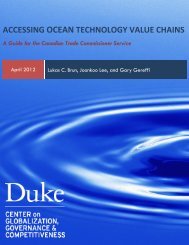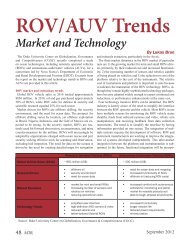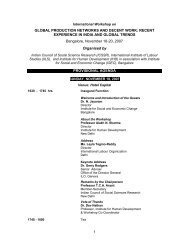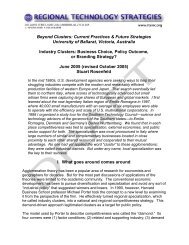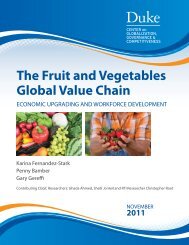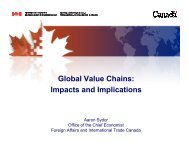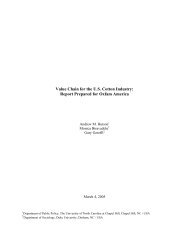Agricultural Value Chains in the Mexicali Valley of Mexico: Main ...
Agricultural Value Chains in the Mexicali Valley of Mexico: Main ...
Agricultural Value Chains in the Mexicali Valley of Mexico: Main ...
Create successful ePaper yourself
Turn your PDF publications into a flip-book with our unique Google optimized e-Paper software.
FIGURE 1: THE MEXICALI VALLEY<br />
Source: Medell<strong>in</strong>-Azuara et al, 2009 [2]<br />
<strong>Agricultural</strong> <strong>Value</strong> <strong>Cha<strong>in</strong>s</strong> <strong>in</strong> <strong>the</strong> <strong>Mexicali</strong> <strong>Valley</strong> <strong>of</strong> <strong>Mexico</strong><br />
The <strong>Mexicali</strong> <strong>Valley</strong>’s climate is characterized as extremely arid with ra<strong>in</strong>fall rarely exceed<strong>in</strong>g 100mm (4<br />
<strong>in</strong>ches) per year. Water used <strong>in</strong> <strong>the</strong> region is supplied by <strong>the</strong> Colorado River and regional aquifers. As a<br />
result <strong>of</strong> <strong>the</strong>1944 U.S.-<strong>Mexico</strong> International Water Treaty, <strong>Mexico</strong> is entitled to receive more than 1,850<br />
million cubic meters (Mm 3 /year) <strong>of</strong> Colorado River water. Accord<strong>in</strong>g to a 2009 study, irrigated agriculture <strong>in</strong><br />
<strong>the</strong> <strong>Mexicali</strong> <strong>Valley</strong> is <strong>the</strong> largest water user <strong>in</strong> <strong>the</strong> region by us<strong>in</strong>g more than 2,000 Mm 3 /year compared to<br />
86 Mm 3 /year and 200 Mm 3 /year supplied for urban consumption for <strong>Mexicali</strong> and overall for Baja<br />
California urban consumption, respectively. 2 One <strong>of</strong> <strong>the</strong> ma<strong>in</strong> water management challenges is supply<strong>in</strong>g<br />
water to <strong>the</strong> grow<strong>in</strong>g urban population <strong>in</strong> <strong>the</strong> <strong>Mexicali</strong> <strong>Valley</strong> while meet<strong>in</strong>g <strong>the</strong> demand for water by<br />
agriculture.<br />
In <strong>Mexicali</strong>, agricultural production takes place throughout <strong>the</strong> year on a rotation basis. Crops are grown<br />
dur<strong>in</strong>g a spr<strong>in</strong>g-summer cycle, a fall-w<strong>in</strong>ter cycle, and perennially. Wheat and green onions are cultivated <strong>in</strong><br />
<strong>the</strong> fall-w<strong>in</strong>ter cycle. Wheat is normally cultivated on <strong>the</strong> same fields as cotton on a rotation basis. Dur<strong>in</strong>g <strong>the</strong><br />
fall-w<strong>in</strong>ter cycle <strong>of</strong> 2008-2009, wheat cultivation area was estimated at 88,582 hectares (ha) and green<br />
onions at 3,587 ha. In <strong>the</strong> 2008 spr<strong>in</strong>g-summer cycle, cotton (19,672 ha.) was <strong>the</strong> major crop cultivated <strong>in</strong> <strong>the</strong><br />
region. Alfalfa (29,907 ha.) and asparagus (1,467 ha.) are <strong>the</strong> major perennial crops grown <strong>in</strong> <strong>the</strong> <strong>Mexicali</strong><br />
<strong>Valley</strong>. In 2008, crops with <strong>the</strong> highest market value were wheat (1,766 million pesos), alfalfa (862 million<br />
pesos), cotton (297 million pesos), asparagus (226 million pesos) and green onions (186 million pesos).<br />
2 Medell<strong>in</strong>-Azuara, J., et al., A CALIBRATED AGRICULTURAL WATER DEMAND MODEL FOR THREE REGIONS IN NORTHERN<br />
BAJA CALIFORNIA. Agrociencia, 2009. 43(2): p. 83-96.<br />
Page 6



